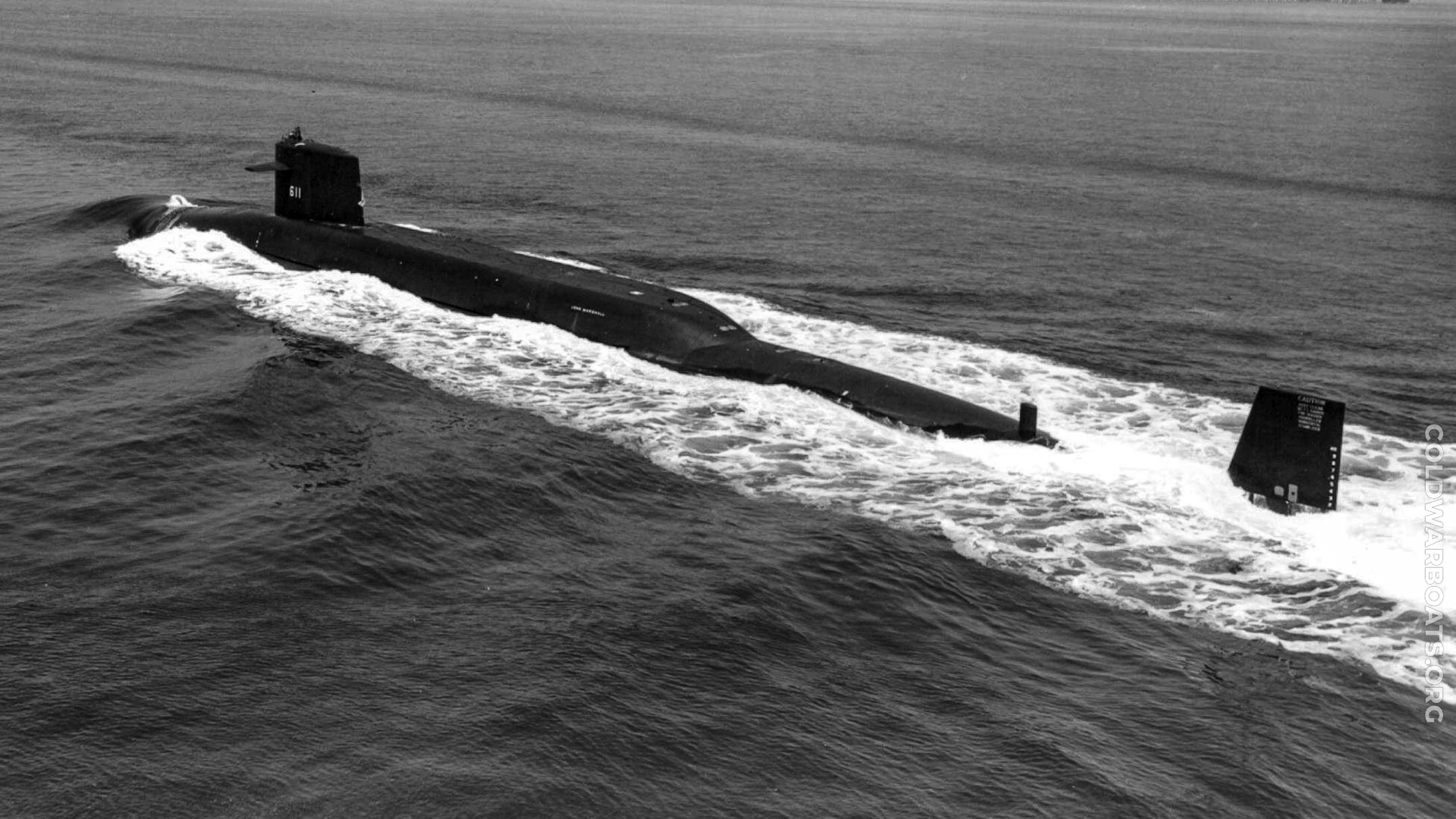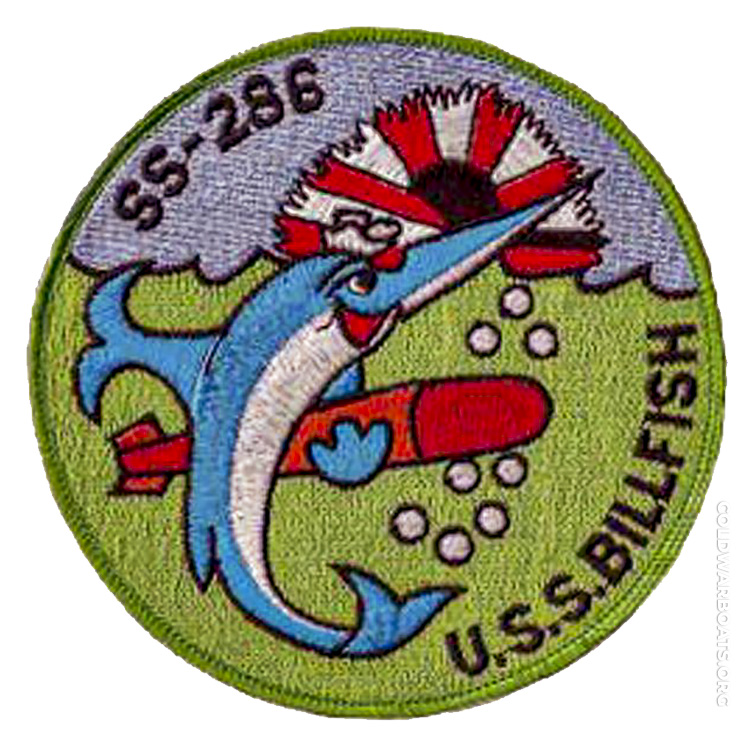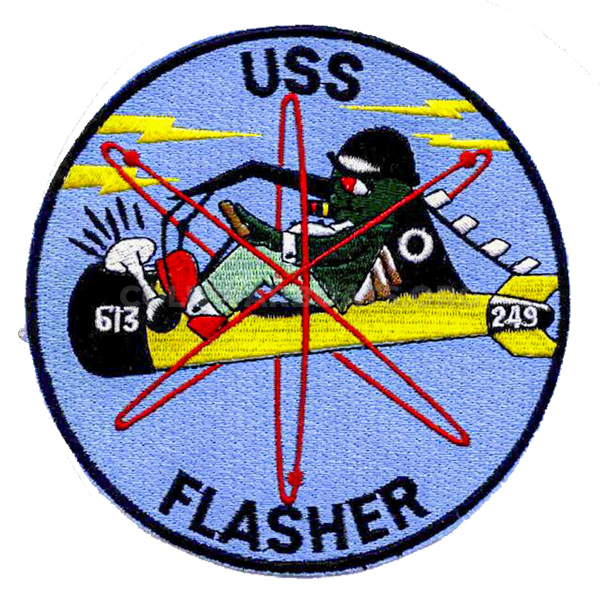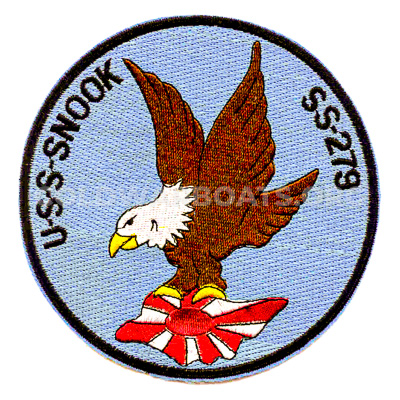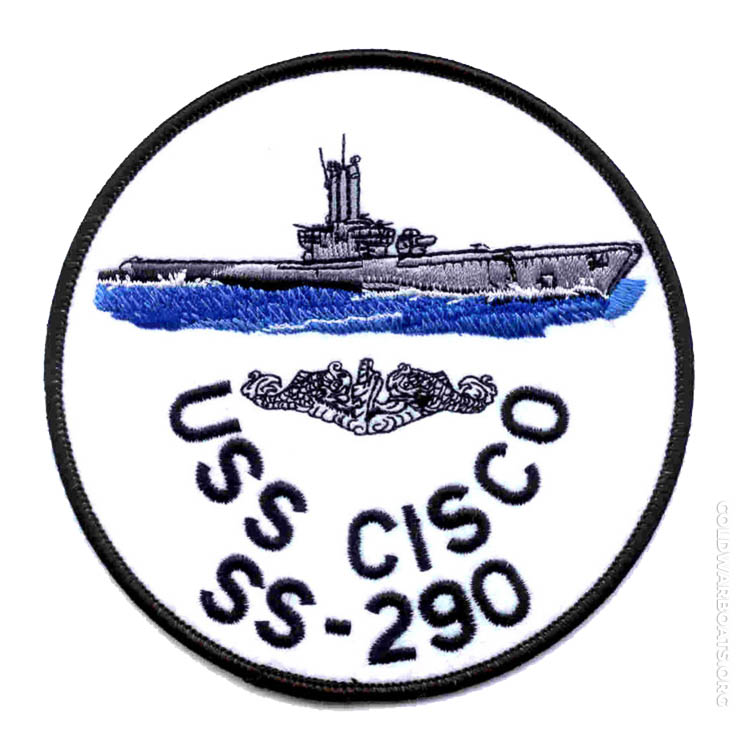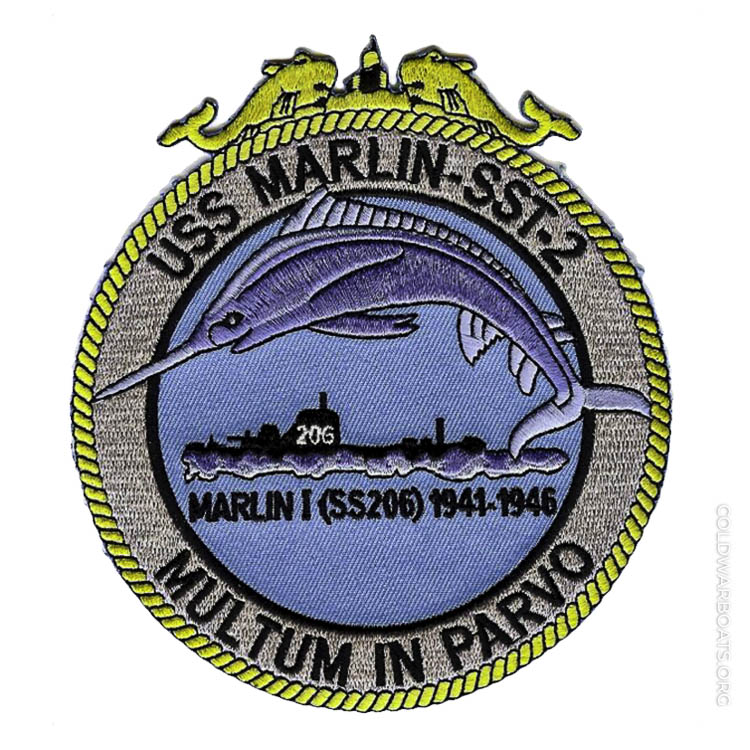~ Veritas Vincit ~
~ Truth Prevails ~
Specifications:
 Keel Laid: 04 APR 60
Keel Laid: 04 APR 60- Launched: 15 JUL 61
- Commissioned: 21 MAY 62
- Decommissioned: 22 JUL 92
- Stricken: 22 JUL 92
- Builder: Newport News Shipbuilding and Drydock Company
- Propulsion system: one S5W nuclear reactor
- Screw: one
- Length: 410 ft (125 meters)
- Beam: 33 ft (10.1 meters)
- Draft: 27 ft (8.4 meters)
- Displacement, surfaced: approx. 6900 tons
- Displacement, submerged: approx. 7900 tons
- Speed: Surfaced: in excess of 16 knots
- Speed: Submerged: in excess of 21 knots
- Armament: 16 fleet ballistic missiles, deactivated 1981; four x 21 inch (530 mm) torpedo tubes
- Crew: 12 Officers, 128 Enlisted
The Sixties:
The keel for the John Marshall was laid at Newport News Shipbuilding and Drydock Company on April 4, 1960. The ship was one of five ETHAN ALLEN class submarines and the fourth nuclear powered submarine built at Newport News.
 John Marshall was launched on July 15, 1961. The ship was christened by Mrs. Robert F. Kennedy during a colorful ceremony in which the Attorney General of the United States, Mr. Robert F. Kennedy, delivered the principal address. The Polaris submarine was hailed by Kennedy as "An awesome weapon to defend our liberties and our rights."
John Marshall was launched on July 15, 1961. The ship was christened by Mrs. Robert F. Kennedy during a colorful ceremony in which the Attorney General of the United States, Mr. Robert F. Kennedy, delivered the principal address. The Polaris submarine was hailed by Kennedy as "An awesome weapon to defend our liberties and our rights."
Sea trials began on April 8, 1962. After the successful completion of the first sea trials, Vice Admiral H. G. Rickover, who was aboard as technical director, expressed personal satisfaction with the trials and thanked the commanding officer and his crew for "their very fine performance."
On May 21, 1962, USS JOHN MARSHALL (SSBN 611) was commissioned at Newport News, Virginia, and joined the Atlantic Fleet as a unit of Submarine Squadron FOURTEEN. Ten days later the ship began its shakedown cruise, which culminated on July 12 with the successful firing of two A-2 Polaris missiles off Cape Canaveral, Florida. On December 31, 1962, John Marshall sailed for its first Polaris patrol. Manned by the BLUE Crew, it became the ninth operational Fleet Ballistic Missile Submarine.
From April 4, 1963 to November 30, 1966, the BLUE and GOLD crews conducted a total of seventeen deterrent patrols from Holy Loch, Scotland.
On December 13, 1966, the ship started its first major overhaul at Newport News Shipbuilding and Drydock Company. The overhaul was completed in April 1968. After the post-overhaul shakedown, the ship loaded missiles in Charleston, South Carolina and in September 1968 began patrol eighteen. Patrols nineteen through twenty-five were conducted from Holy Loch, Scotland from October 1968 through June 1970.
The Seventies:
In June 1970, the ship became a unit of Submarine Squadron SIXTEEN and began operations from Rota, Spain.
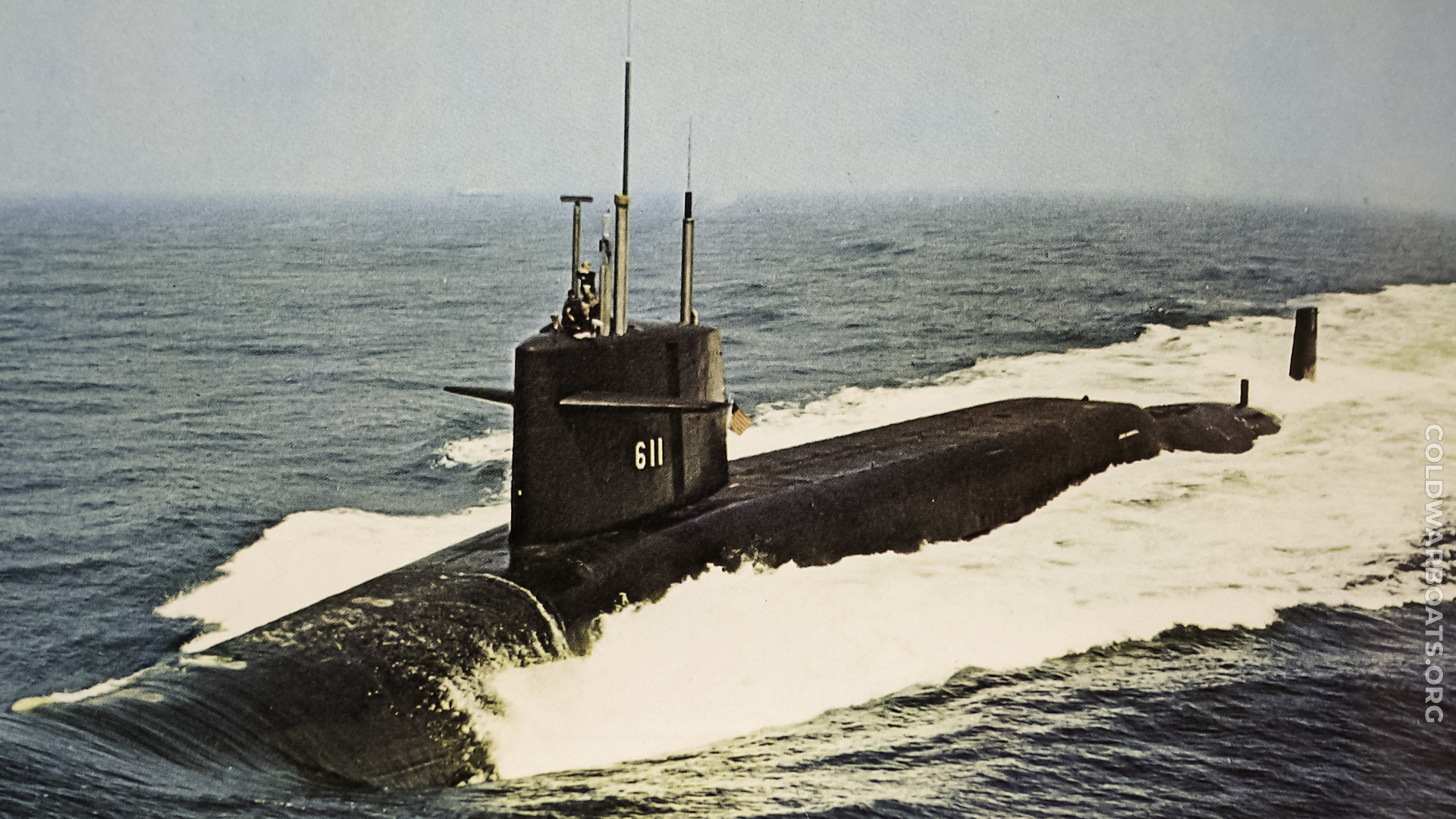 Patrols twenty-six through thirty-seven were conducted from Rota. The ship was awarded its first Meritorious Unit Commendation as a result of an operation conducted i n March 1971 that demonstrated the effectiveness and dependability of the Fleet Ballistic Missile System. In June 1973, the ship returned to New London, Connecticut for a dependents' cruise, then conducted two patrols from Charleston,
Patrols twenty-six through thirty-seven were conducted from Rota. The ship was awarded its first Meritorious Unit Commendation as a result of an operation conducted i n March 1971 that demonstrated the effectiveness and dependability of the Fleet Ballistic Missile System. In June 1973, the ship returned to New London, Connecticut for a dependents' cruise, then conducted two patrols from Charleston,
South Carolina.
On November 1, 1974, John Marshall began its second refueling overhaul at Mare Island Naval Shipyard. During this overhaul, the missile systems were converted to support the Polaris A-3 system. The overhaul was completed in May 1976 and the ship commenced strategic deterrent patrols i n February 1977 as a unit of Submarine Squadron FIFTEEN.
The Eighties:
Patrols forty through fifty-four were conducted from Apra Harbor, Guam. The final deterrent patrol concluded with the ship's arrival at Pearl Harbor, Hawaii on December 28, 1980.
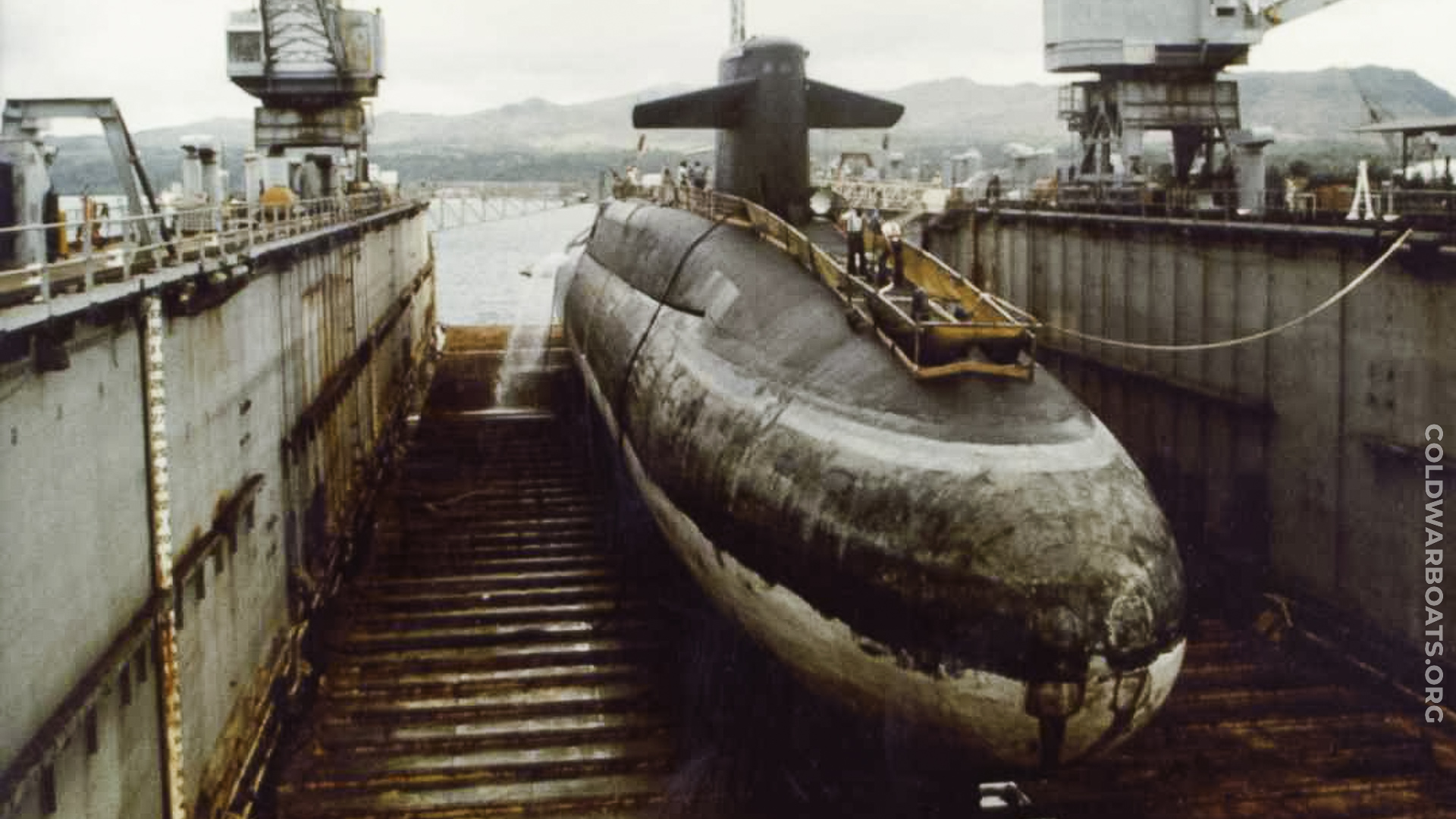 On January 12, 1981 John Marshall was designated as SSN and USS JOHN MARSHALL (SSN 611) began operations as an attack submarine from Pearl Harbor. The last Polaris missile was removed i n Bangor, Washington on June 1, 1981.
On January 12, 1981 John Marshall was designated as SSN and USS JOHN MARSHALL (SSN 611) began operations as an attack submarine from Pearl Harbor. The last Polaris missile was removed i n Bangor, Washington on June 1, 1981.
The ship arrived in Charleston, South Carolina on July 20, 1981 and began operations as a unit of Submarine Squadron FOUR. On December 28, 1981, the ship departed for its first deployment
to the Mediterranean Sea. The deployment included several major fleet exercises and visits to La Maddalena, Italy; Tangiers, Morocco; and Lisbon, Portugal. The ship returned to Charleston on May 21, 1982, twenty years to the day after it was commissioned.
In September 1983, John Marshall again returned to the Pacific Fleet and arrived at Puget Sound Naval Shipyard on September 29 to start its third overhaul. The ship was modified to support operations with Dry Deck Shelters capable of deploying SEAL Delivery Vehicles. Post-overhaul sea trials were conducted in September 1985 and the ship joined Submarine Squadron SIX in Norfolk, Virginia
in November 1985.
On December 15, 1986, the ship, equipped with a Dry Deck Shelter, began its transit for its second deployment to the Mediterranean Sea. The deployment included several exercises, a demonstration of the ship's unique special warfare capability and visits to Toulon, France and La Maddalena, Italy. The ship returned to Norfolk on May 29, 1987. In September 1987 a Special Operational Demonstration was conducted near Puerto Rico with SEAL Delivery Vehicle Team TWO.
Operations in 1988 included battlegroup exercises, Special Acoustic Trials, and Dry Deck Shelter operations.
The 1,000th dive of the ship was conducted off of Puerto Rico on October 25, 1988.
On May 1, 1989, after conducting a variety of exercises with carrier battlegroups and other submarines, the ship departed for its third Mediterranean deployment. This was the first time a submarine had deployed anywhere in the world with two Dry Deck Shelters on board, adding a unique flexibility and endurance to the Fleet Commander for special warfare operations. Embarked o n board when the ship
departed Norfolk was the largest special warfare detachment in the Atlantic or Mediterranean. During the 1989 deployment, the ship's response to contingency operations, providing forward area support of a unique nature on extremely short notice, as well as the ship's success with ASW operations, was recognized i n the award of the Meritorious Unit Commendation. The ship returned to Norfolk in September 1989.
The Nineties:
The ship conducted three special warfare training exercises in the Caribbean Sea in 1990, including a highly successful exercise that featured the employment of Submarine Launched Mobile Mines.
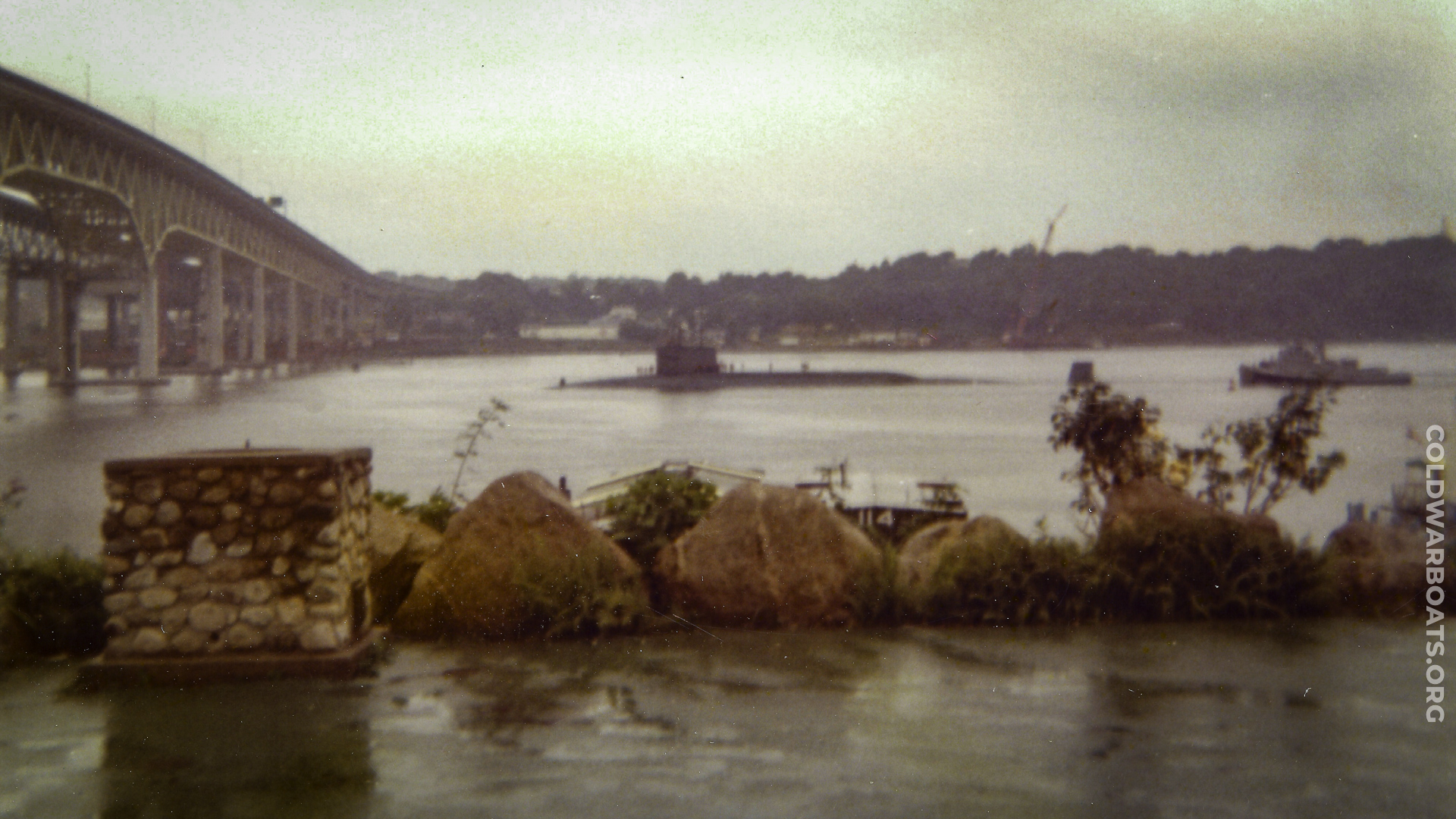 On January 26, 1991, the ship departed Norfolk for its fourth and final deployment to the Mediterranean. Equipped once again with two Dry Deck Shelters, the ship operated in direct support o f Operation Desert Storm and provided significant capability options to the Sixth Fleet Commander. The ship visited Toulon, France; Gibraltar; and La Maddalena, Italy, returning to Norfolk on June 22, 1991.
On January 26, 1991, the ship departed Norfolk for its fourth and final deployment to the Mediterranean. Equipped once again with two Dry Deck Shelters, the ship operated in direct support o f Operation Desert Storm and provided significant capability options to the Sixth Fleet Commander. The ship visited Toulon, France; Gibraltar; and La Maddalena, Italy, returning to Norfolk on June 22, 1991.
In September 1991, John Marshall served as flagship for the largest submarine/special warfare exercise since World War II. Over 191 personnel, including three flag officers and Navy SEAL and Army special forces, embarked to conduct joint special operations during Exercise Phantom Shadow.
On November 23, 1991, a deactivation ceremony was conducted in Norfolk, Virginia. The ship's first commanding officer was the featured speaker.
On January 6, 1992, the ship departed Norfolk for the last time. Transit of the Panama Canal was conducted on January 13 and the ship arrived in San Diego, California on January 23 for a port visit. The ship departed San Diego on January 27 for the final submerged transit. Twenty five guests were onboard, including the ship's first commanding officer and another plankowner.
The ship arrived at Bangor, Washington on January 31, 1992 and conducted offload of repair parts, stores and munitions. On 6 February 1992, the ship put to sea for the last time, conducting a one day transit to Puget Sound Naval Shipyard for deactivation.
The ship's anchor was placed on permanent display at Hidden Creek Elementary School in Port Orchard, Washington, on June 11, 1992.
USS JOHN MARSHALL (SSBN 611) was decommissioned on July 22, 1992.
Sources:
Documentation of the USS JOHN MARSHALL (SSBN 611)
Dictionary of American Naval Fighting Ships, www.navysite.de, Wikipedia

